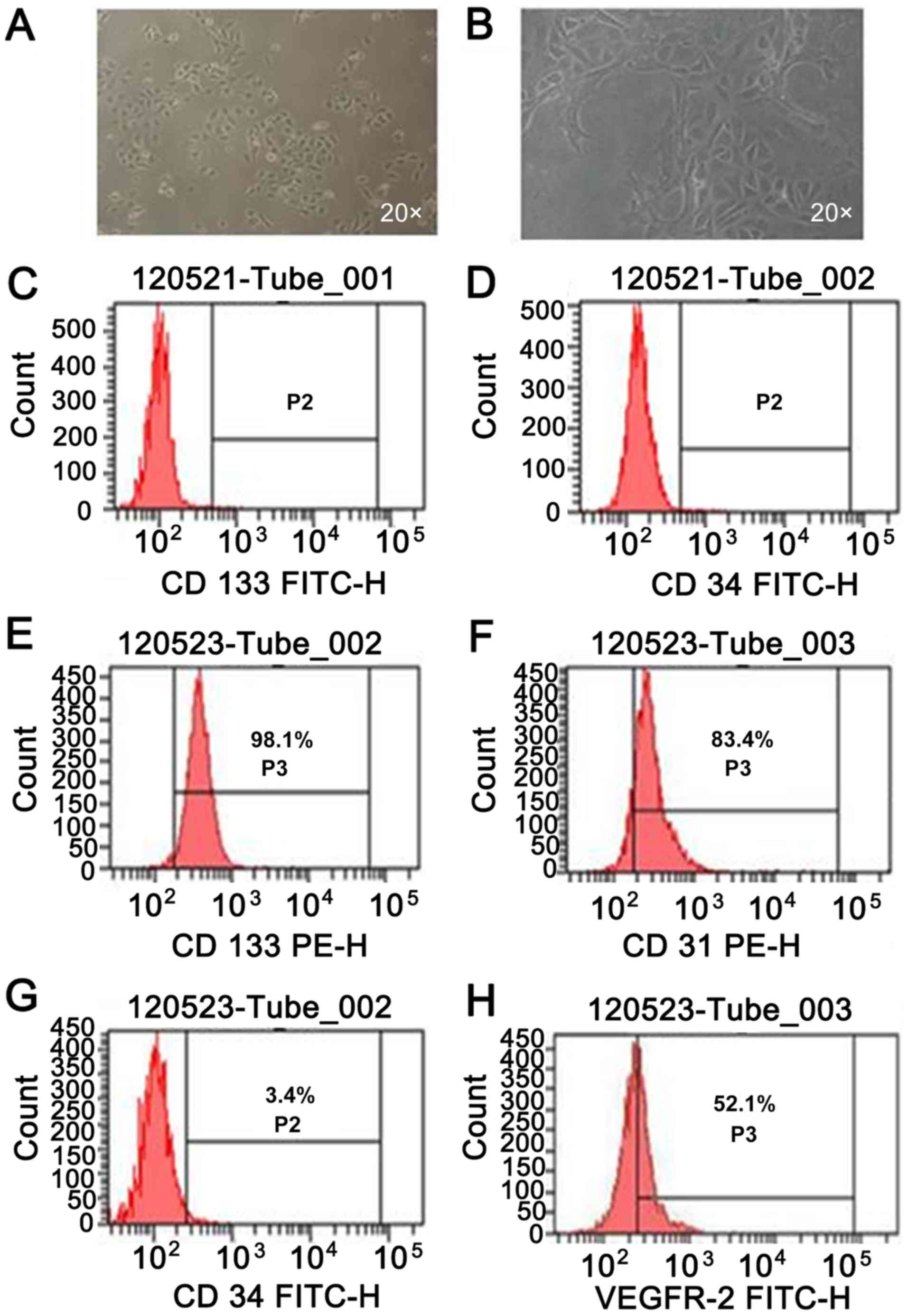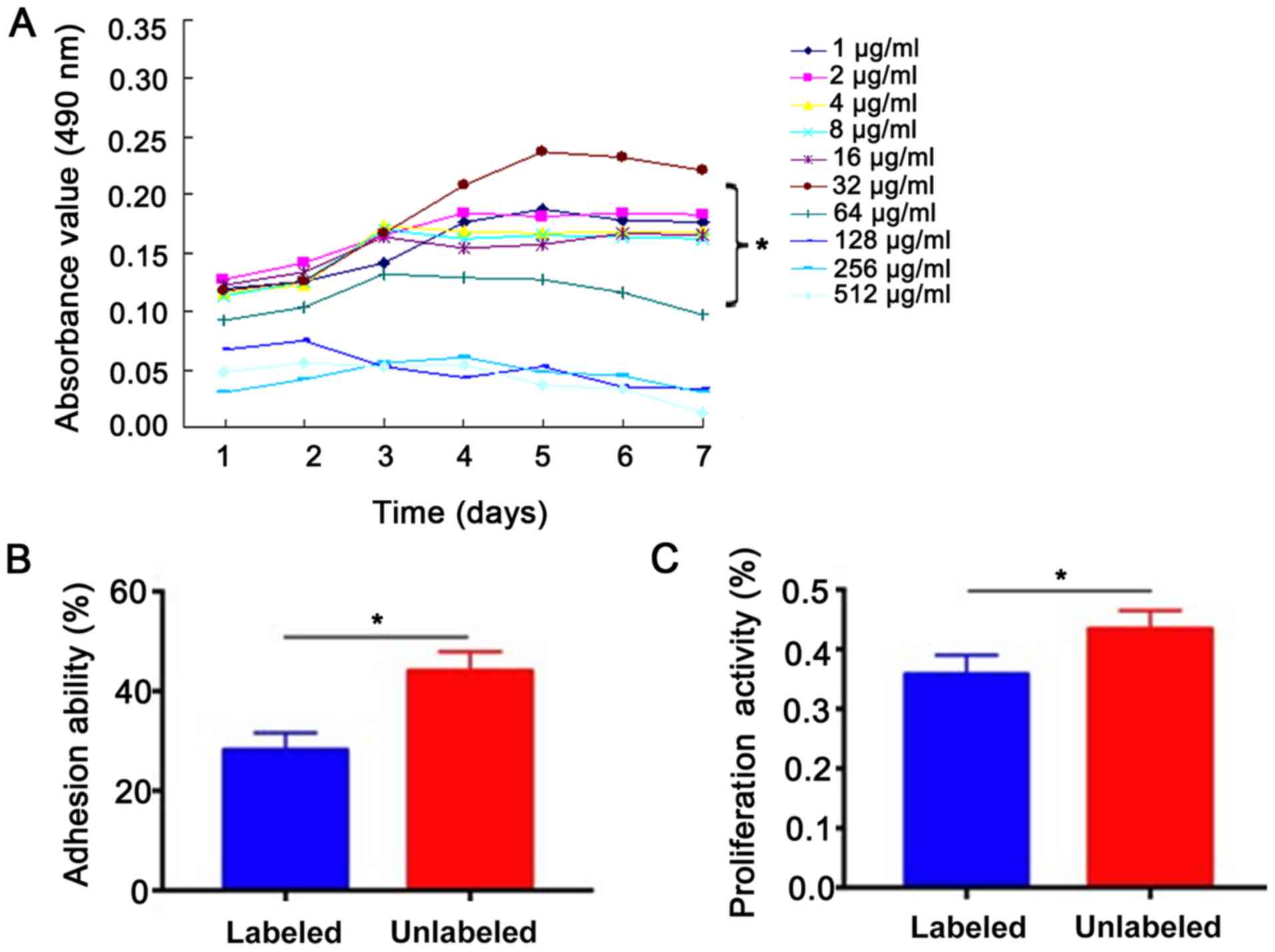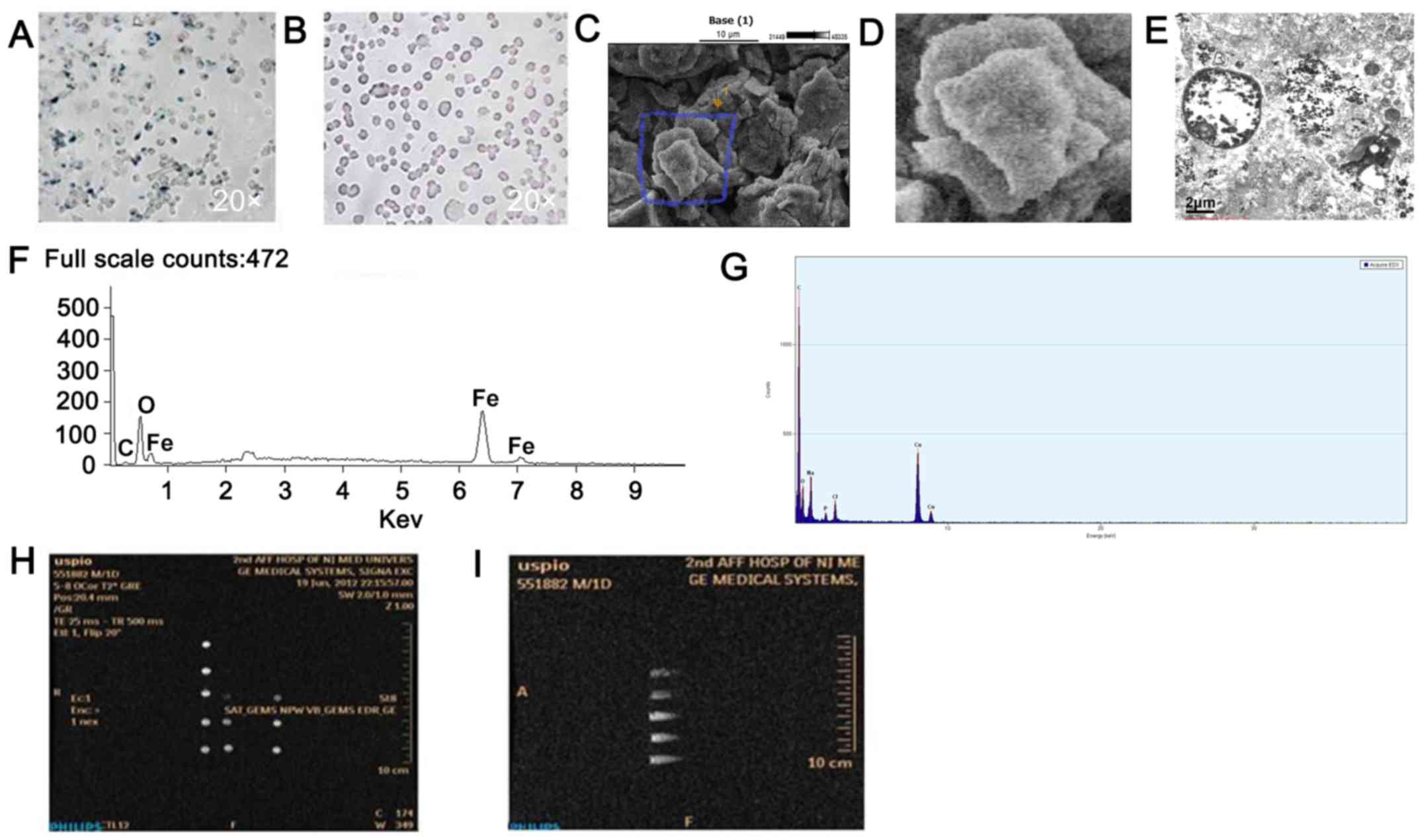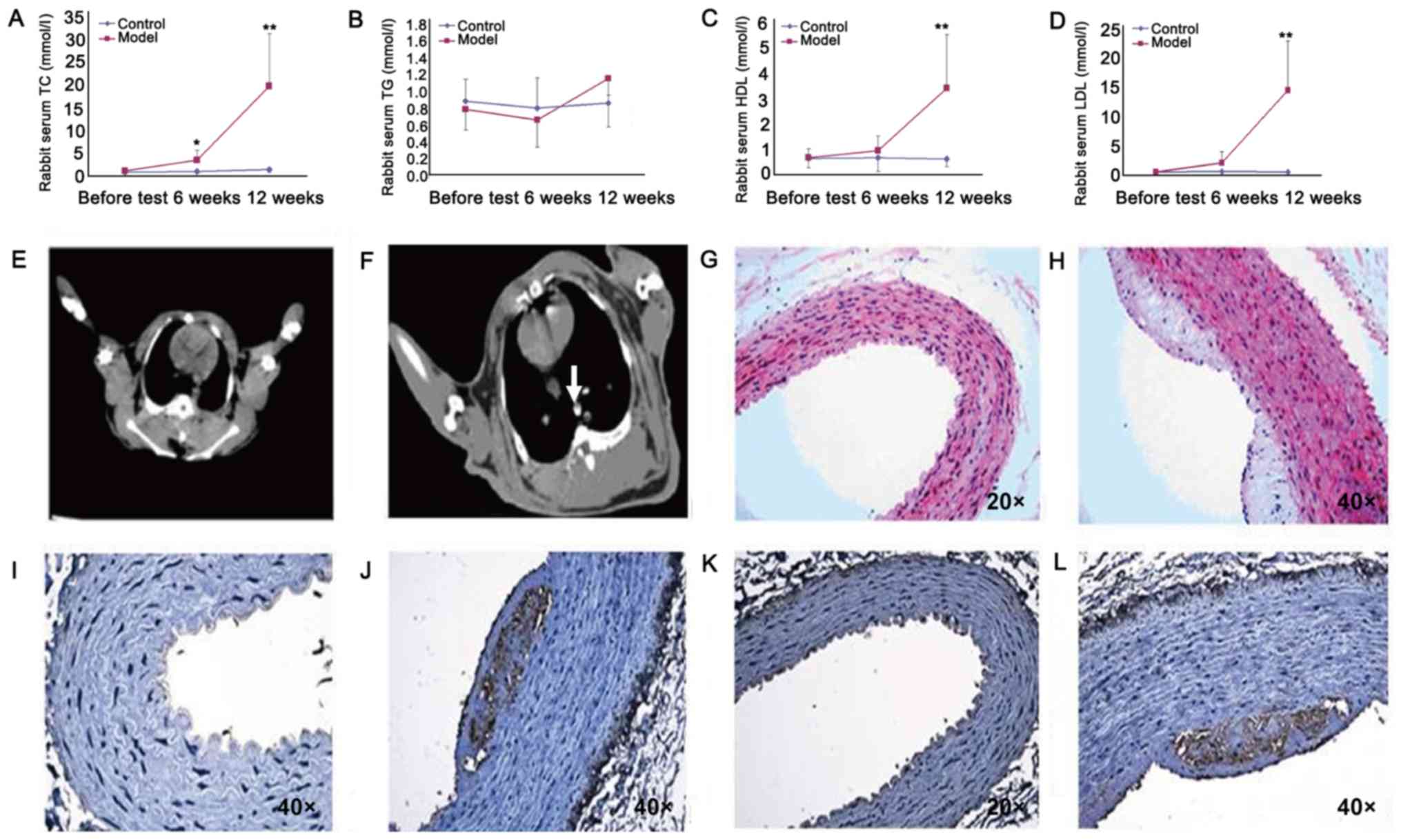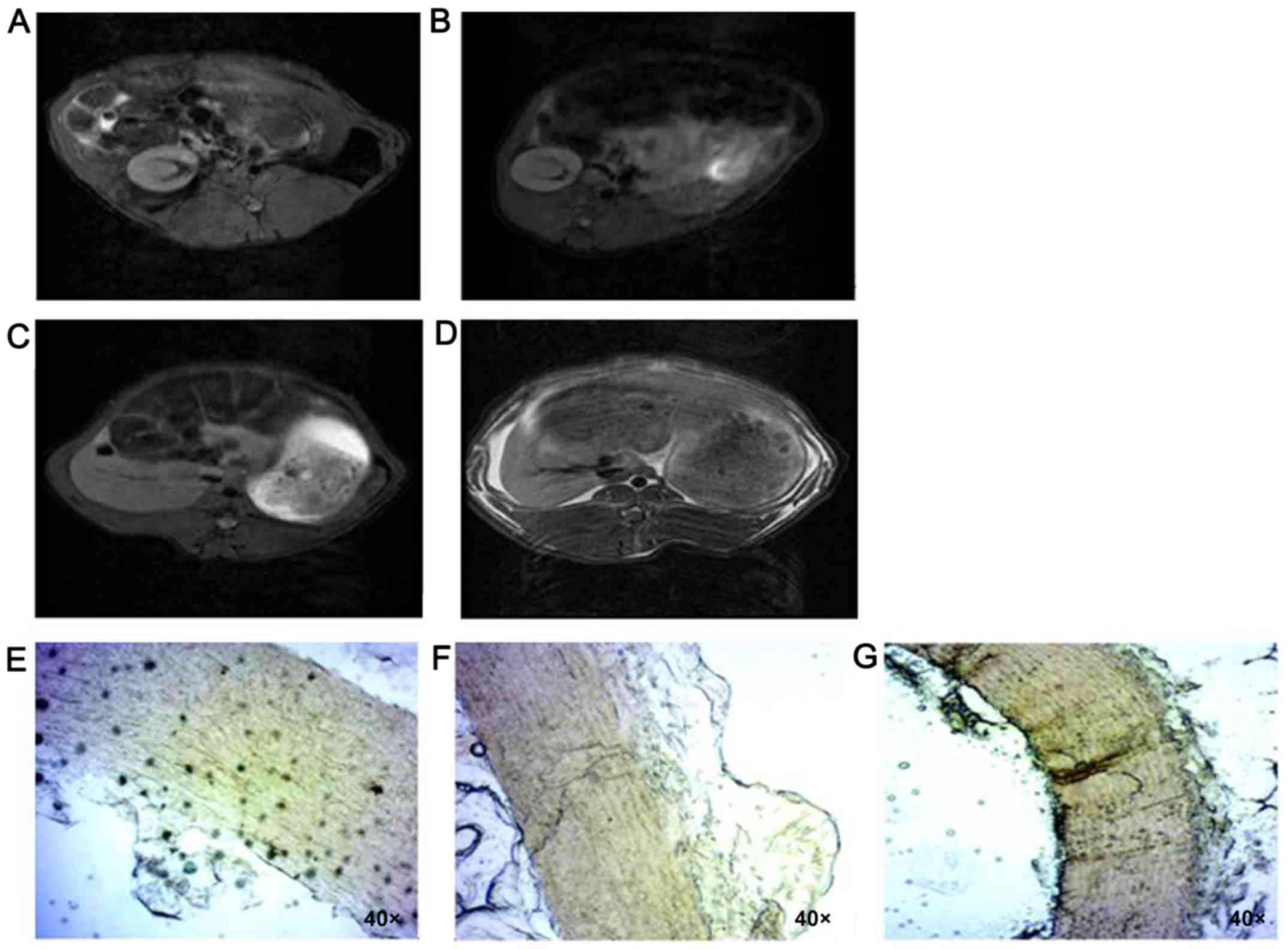|
1
|
Zhang Y, Koradia A, Kamato D, Popat A,
Little PJ and Ta HT: Treatment of atherosclerotic plaque:
Perspectives on theranostics. J Pharmacy Pharmacol:. 71:3327–1043.
2019. View Article : Google Scholar
|
|
2
|
World Health Organization (WHO), World
Heart Federation, Organization WS, . Global atlas on cardiovascular
disease prevention and control Policies, strategies and
interventions. WHO; Geneva: 2011
|
|
3
|
Benjamin EJ, Blaha MJ, Chiuve SE, Cushman
M, Das SR, Deo R, de Ferranti SD, Floyd J, Fornage M, Gillespie C,
et al: Heart disease and stroke statistics-2017 update: A report
from the american heart association. Circulation. 135:e146–e603.
2017. View Article : Google Scholar : PubMed/NCBI
|
|
4
|
World Health Organization (WHO), .
Cardiovascular diseases (CVDs). WHO; Geneva: 2020, https://www.who.int/en/news-room/fact-sheets/detail/cardiovascular-diseases-(cvds)April
6–2020
|
|
5
|
Biancari F, Anttila V, Dell'Aquila AM,
Airaksinen JKE and Brascia D: Control angiography for perioperative
myocardial Ischemia after coronary surgery: Meta-analysis. J
Cardiothorac Surg. 13:242018. View Article : Google Scholar : PubMed/NCBI
|
|
6
|
Athyros VG, Tziomalos K, Katsiki N and
Mikhailidis DP: Novel data on the pathogenesis of atherosclerosis,
treatment targets, and new therapeutic interventions in
lipid-related cardiovascular risk factors. Curr Pharm Des.
20:6215–6219. 2014. View Article : Google Scholar : PubMed/NCBI
|
|
7
|
Rabelink TJ, de Boer HC and van Zonneveld
AJ: Endothelial activation and circulating markers of endothelial
activation in kidney disease. Nat Rev Nephrol. 6:404–414. 2010.
View Article : Google Scholar : PubMed/NCBI
|
|
8
|
Gimbrone MA Jr and Garcia-Cardena G:
Endothelial cell dysfunction and the pathobiology of
atherosclerosis. Circ Res. 118:620–636. 2016. View Article : Google Scholar : PubMed/NCBI
|
|
9
|
Cahill PA and Redmond EM: Vascular
endothelium-Gatekeeper of vessel health. Atherosclerosis.
248:97–109. 2016. View Article : Google Scholar : PubMed/NCBI
|
|
10
|
Theodorou K and Boon RA: Endothelial cell
metabolism in atherosclerosis. Front Cell Dev Biol. 6:822018.
View Article : Google Scholar : PubMed/NCBI
|
|
11
|
Kwon Y, Norby FL, Jensen PN, Agarwal SK,
Soliman EZ, Lip GY, Longstreth WT Jr, Alonso A, Heckbert SR and
Chen LY: Association of smoking, alcohol, and obesity with
cardiovascular death and ischemic stroke in atrial fibrillation:
The atherosclerosis risk in communities (ARIC) study and
cardiovascular health study (CHS). PLoS One. 11:e01470652016.
View Article : Google Scholar : PubMed/NCBI
|
|
12
|
Ruan C, Shen Y, Chen R, Wang Z, Li J and
Jiang Y: Endothelial progenitor cells and atherosclerosis. Front
Biosci (Landmark Ed). 18:1194–1201. 2013. View Article : Google Scholar : PubMed/NCBI
|
|
13
|
Yoder MC: Human endothelial progenitor
cells. Cold Spring Harb Perspect Med. 2:a0066922012. View Article : Google Scholar : PubMed/NCBI
|
|
14
|
Peters EB: Endothelial progenitor cells
for the vascularization of engineered tissues. Tissue Eng Part B
Rev. 24:1–24. 2018. View Article : Google Scholar : PubMed/NCBI
|
|
15
|
Li DW, Liu ZQ, Wei J, Liu Y and Hu LS:
Contribution of endothelial progenitor cells to neovascularization
(Review). Int J Mol Med. 30:1000–1006. 2012. View Article : Google Scholar : PubMed/NCBI
|
|
16
|
Mudyanadzo TA: Endothelial progenitor
cells and cardiovascular correlates. Cureus.
10:e33422018.PubMed/NCBI
|
|
17
|
Grisar JC, Haddad F, Gomari FA and Wu JC:
Endothelial progenitor cells in cardiovascular disease and chronic
inflammation: From biomarker to therapeutic agent. Biomark Med.
5:731–744. 2011. View Article : Google Scholar : PubMed/NCBI
|
|
18
|
Dzau VJ, Gnecchi M, Pachori AS, Morello F
and Melo LG: Therapeutic potential of endothelial progenitor cells
in cardiovascular diseases. Hypertension. 46:7–18. 2005. View Article : Google Scholar : PubMed/NCBI
|
|
19
|
Qiu Y, Zhang C, Zhang G and Tao J:
Endothelial progenitor cells in cardiovascular diseases. Aging Med.
1:204–208. 2018. View Article : Google Scholar
|
|
20
|
Gao X, Chen W, Liang Z and Chen L:
Autotransplantation of circulating endothelial progenitor cells
protects against lipopolysaccharide-induced acute lung injury in
rabbit. Int Immunopharmacol. 11:1584–1590. 2011. View Article : Google Scholar : PubMed/NCBI
|
|
21
|
Chen ZZ, Jiang XD, Zhang LL, Shang JH, Du
MX, Xu G and Xu RX: Beneficial effect of autologous transplantation
of bone marrow stromal cells and endothelial progenitor cells on
cerebral ischemia in rabbits. Neurosci Lett. 445:36–41. 2008.
View Article : Google Scholar : PubMed/NCBI
|
|
22
|
Chen B, Bo CJ, Jia RP, Liu H, Wu R, Wu J,
Ge YZ and Teng GJ: The renoprotective effect of bone marrow-derived
endothelial progenitor cell transplantation on acute
ischemia-reperfusion injury in rats. Transplant Pro. 45:2034–2039.
2013. View Article : Google Scholar
|
|
23
|
Li ZF, Fang XG, Yang PF, Huang QH, Zhao
WY, Liang C, Zhao R and Liu JM: Endothelial progenitor cells
contribute to neointima formation in rabbit elastase-induced
aneurysm after flow diverter treatment. CNS Neurosci Ther.
19:352–357. 2013. View Article : Google Scholar : PubMed/NCBI
|
|
24
|
Cui K, Ma X, Yu L, Jiang C, Fu C, Fu X, Yu
X, Huang Y, Hou S, Si C, et al: Autologous bone marrow mononuclear
cell transplantation delays progression of carotid atherosclerosis
in rabbits. Mol Neurobiol. 53:4387–4396. 2016. View Article : Google Scholar : PubMed/NCBI
|
|
25
|
Zhang M, Malik AB and Rehman J:
Endothelial progenitor cells and vascular repair. Curr Opin
Hematol. 21:224–228. 2014. View Article : Google Scholar : PubMed/NCBI
|
|
26
|
Rajendran P, Rengarajan T, Thangavel J,
Nishigaki Y, Sakthisekaran D, Sethi G and Nishigaki I: The vascular
endothelium and human diseases. Int J Biol Sci. 9:1057–1069. 2013.
View Article : Google Scholar : PubMed/NCBI
|
|
27
|
Kruger-Genge A, Blocki A, Franke RP and
Jung F: Vascular endothelial cell biology: An update. Int J Mol
Sci. 20:44112019. View Article : Google Scholar
|
|
28
|
Asahara T, Murohara T, Sullivan A, Silver
M, van der Zee R, Li T, Witzenbichler B, Schatteman G and Isner JM:
Isolation of putative progenitor endothelial cells for
angiogenesis. Science. 275:964–967. 1997. View Article : Google Scholar : PubMed/NCBI
|
|
29
|
Pirro M, Stingeni L, Vaudo G, Mannarino
MR, Ministrini S, Vonella M, Hansel K, Bagaglia F, Alaeddin A, Lisi
P and Mannarino E: Systemic inflammation and imbalance between
endothelial injury and repair in patients with psoriasis are
associated with preclinical atherosclerosis. Eur J Prev Cardiol.
22:1027–1035. 2015. View Article : Google Scholar : PubMed/NCBI
|
|
30
|
Groleau J, Dussault S, Haddad P, Turgeon
J, Menard C, Chan JS and Rivard A: Essential role of copper-zinc
superoxide dismutase for ischemia-induced neovascularization via
modulation of bone marrow-derived endothelial progenitor cells.
Arterioscler Thromb Vasc Biol. 30:2173–2181. 2010. View Article : Google Scholar : PubMed/NCBI
|
|
31
|
Ankeny RF, Ankeny CJ, Nerem RM and Jo H:
Maturing EPCs into endothelial cells: May the force be with the
EPCs: Focus on ‘Fluid shear stress induces differentiation of
circulating phenotype endothelial progenitor cells’. Am J Physiol
Cell Physiol. 303:C589–C591. 2012. View Article : Google Scholar : PubMed/NCBI
|
|
32
|
Psaltis PJ and Simari RD: Vascular wall
progenitor cells in health and disease. Circ Res. 116:1392–1412.
2015. View Article : Google Scholar : PubMed/NCBI
|
|
33
|
Zhang X, Mao H, Chen JY, Wen S, Li D, Ye M
and Lv Z: Increased expression of microRNA-221 inhibits PAK1 in
endothelial progenitor cells and impairs its function via
c-Raf/MEK/ERK pathway. Biochem Biophys Res Commun. 431:404–408.
2013. View Article : Google Scholar : PubMed/NCBI
|
|
34
|
Aicher A, Brenner W, Zuhayra M, Badorff C,
Massoudi S, Assmus B, Eckey T, Henze E, Zeiher AM and Dimmeler S:
Assessment of the tissue distribution of transplanted human
endothelial progenitor cells by radioactive labeling. Circulation.
107:2134–2139. 2003. View Article : Google Scholar : PubMed/NCBI
|
|
35
|
Asahara T, Kawamoto A and Masuda H:
Concise review: Circulating endothelial progenitor cells for
vascular medicine. Stem Cells. 29:1650–1655. 2011. View Article : Google Scholar : PubMed/NCBI
|
|
36
|
Nuzzolo ER, Capodimonti S, Martini M,
Iachininoto MG, Bianchi M, Cocomazzi A, Zini G, Leone G, Larocca LM
and Teofili L: Adult and cord blood endothelial progenitor cells
have different gene expression profiles and immunogenic potential.
Blood Transfus. 12 (Suppl 1):S367–S374. 2014.PubMed/NCBI
|
|
37
|
Souidi N, Stolk M, Rudeck J, Strunk D,
Schallmoser K, Volk HD and Seifert M: Stromal cells act as
guardians for endothelial progenitors by reducing their
immunogenicity after co-transplantation. Stem Cells. 35:1233–1245.
2017. View Article : Google Scholar : PubMed/NCBI
|
|
38
|
Ladhoff J, Fleischer B, Hara Y, Volk HD
and Seifert M: Immune privilege of endothelial cells differentiated
from endothelial progenitor cells. Cardiovasc Res. 88:121–129.
2010. View Article : Google Scholar : PubMed/NCBI
|
|
39
|
Fang J, Guo Y, Tan S, Li Z, Xie H, Chen P,
Wang K, He Z, He P, Ke Y, et al: Autologous endothelial progenitor
cells transplantation for acute ischemic stroke: A 4-Year Follow-Up
Study. Stem Cells Transl Med. 8:14–21. 2019. View Article : Google Scholar : PubMed/NCBI
|
|
40
|
Fan CL, Gao PJ, Che ZQ, Liu JJ, Wei J and
Zhu DL: Therapeutic neovascularization by autologous
transplantation with expanded endothelial progenitor cells from
peripheral blood into ischemic hind limbs. Acta Pharmacol Sin.
26:1069–1075. 2005. View Article : Google Scholar : PubMed/NCBI
|
|
41
|
Yin Y, Liu H, Wang F, Li L, Deng M, Huang
L and Zhao X: Transplantation of cryopreserved human umbilical cord
blood-derived endothelial progenitor cells induces recovery of
carotid artery injury in nude rats. Stem Cell Res Ther. 6:372015.
View Article : Google Scholar : PubMed/NCBI
|
|
42
|
Suzuki M, Bachelet-Violette L, Rouzet F,
Beilvert A, Autret G, Maire M, Menager C, Louedec L, Choqueux C,
Saboural P, et al: Ultrasmall superparamagnetic iron oxide
nanoparticles coated with fucoidan for molecular MRI of
intraluminal thrombus. Nanomedicine (Lond). 10:73–87. 2015.
View Article : Google Scholar : PubMed/NCBI
|
|
43
|
Usman A, Sadat U, Patterson AJ, Tang TY,
Varty K, Boyle JR, Armon MP, Hayes PD, Graves MJ and Gillard JH:
Use of ultrasmall superparamagnetic iron oxide particles for
imaging carotid atherosclerosis. Nanomedicine (Lond). 10:3077–3087.
2015. View Article : Google Scholar : PubMed/NCBI
|
|
44
|
Zhao X, Zhao H, Chen Z and Lan M:
Ultrasmall superparamagnetic iron oxide nanoparticles for magnetic
resonance imaging contrast agent. J Nanosci Nanotechnol.
14:210–220. 2014. View Article : Google Scholar : PubMed/NCBI
|
|
45
|
Fang Y, Wu Y, Liao P, Chen Z, Chen H, Yu
J, Liu Y, Li S, Su E, He N, et al: Design and application of a
high-throughput sample processing module based on magnetic beads.
Nanosci Nanotech Lett. 10:320–328. 2018. View Article : Google Scholar
|
|
46
|
Chen Z, Wu Y, Kang M, He N, Wan S, Su E
and Lijun W: Research on automated nucleic acid extraction
instrument based on magnetic nanoparticles separation. Nanosci
Nanotech Lett. 10:60–68. 2018. View Article : Google Scholar
|
|
47
|
Liu H, Dong H, Chen Z, Lin L, Chen H, Li S
and Deng Y: Magnetic nanoparticles enhanced microarray detection of
multiple foodborne pathogens. J Biomed Nanotech. 13:1333–1343.
2017. View Article : Google Scholar
|
|
48
|
Wang X, Zhang T, Zhao X, Guan Z, Wang Z,
Zhu Z, Xie Q, Wang J and Niu B: Quantification of folate
metabolites in serum using ultraperformance liquid chromatography
tandem mass spectrometry. J Chromatogr B Analyt Technol Biomed Life
Sci. 962:9–13. 2014. View Article : Google Scholar : PubMed/NCBI
|
|
49
|
Ittrich H, Peldschus K, Raabe N, Kaul M
and Adam G: Superparamagnetic iron oxide nanoparticles in
biomedicine: Applications and developments in diagnostics and
therapy. Rofo. 185:1149–1166. 2013. View Article : Google Scholar : PubMed/NCBI
|
|
50
|
Guo L, Chen H, He N and Deng Y: Effects of
surface modifications on the physicochemical properties of iron
oxide nanoparticles and their performance as anticancer drug
carriers. Chin Chem Lett. 29:1829–1833. 2018. View Article : Google Scholar
|
|
51
|
Ma ZL, Mai XL, Sun JH, Ju SH, Yang X, Ni Y
and Teng GJ: Inhibited atherosclerotic plaque formation by local
administration of magnetically labeled endothelial progenitor cells
(EPCs) in a rabbit model. Atherosclerosis. 205:80–86. 2009.
View Article : Google Scholar : PubMed/NCBI
|
|
52
|
Lipman NS, Marini RP and Erdman SE: A
comparison of ketamine/xylazine and ketamine/xylazine/acepromazine
anesthesia in the rabbit. Lab Anim Sci. 40:395–398. 1990.PubMed/NCBI
|
|
53
|
Marini RP, Li X, Harpster NK and Dangler
C: Cardiovascular pathology possibly associated with
ketamine/xylazine anesthesia in Dutch belted rabbits. Lab Anim Sci.
49:153–160. 1999.PubMed/NCBI
|
|
54
|
Baneux PJ, Garner D, McIntyre HB and
Holshuh HJ: Euthanasia of rabbits by intravenous administration of
ketamine. J Am Vet Med Assoc. 189:1038–1039. 1986.PubMed/NCBI
|
|
55
|
Cicero L, Fazzotta S, Palumbo VD, Cassata
G and Lo Monte AI: Anesthesia protocols in laboratory animals used
for scientific purposes. Acta Biomed. 89:337–342. 2018.PubMed/NCBI
|
|
56
|
Huang YH, Xu Q, Shen T, Li JK, Sheng JY
and Shi HJ: Prevention of in-stent restenosis with endothelial
progenitor cell (EPC) capture stent placement combined with
regional EPC transplantation: An atherosclerotic rabbit model.
Cardiol J. 26:283–291. 2019. View Article : Google Scholar : PubMed/NCBI
|
|
57
|
Patel J, Seppanen EJ, Rodero MP, Wong HY,
Donovan P, Neufeld Z, Fisk NM, Francois M and Khosrotehrani K:
Functional definition of progenitors versus mature endothelial
cells reveals key SoxF-dependent differentiation process.
Circulation. 135:786–805. 2017. View Article : Google Scholar : PubMed/NCBI
|
|
58
|
Flores-Nascimento MC, Alessio AM, de
Andrade Orsi FL and Annichino-Bizzacchi JM: CD144, CD146 and
VEGFR-2 properly identify circulating endothelial cell. Rev Bras
Hematol Hemoter. 37:98–102. 2015. View Article : Google Scholar : PubMed/NCBI
|
|
59
|
Wei L, Wei ZZ, Jiang MQ, Mohamad O and Yu
SP: Stem cell transplantation therapy for multifaceted therapeutic
benefits after stroke. Prog Neurobiol. 157:49–78. 2017. View Article : Google Scholar : PubMed/NCBI
|
|
60
|
Kamelska-Sadowska AM, Wojtkiewicz J and
Kowalski IM: Review of the current knowledge on the role of stem
cell transplantation in neurorehabilitation. Biomed Res Int.
2019:32908942019. View Article : Google Scholar : PubMed/NCBI
|
|
61
|
Cho J, D'Antuono M, Glicksman M, Wang J
and Jonklaas J: A review of clinical trials: Mesenchymal stem cell
transplant therapy in type 1 and type 2 diabetes mellitus. Am J
Stem Cells. 7:82–93. 2018.PubMed/NCBI
|
|
62
|
Chong MS, Ng WK and Chan JK: Concise
review: Endothelial progenitor cells in regenerative medicine:
Applications and challenges. Stem Cells Transl Med. 5:530–538.
2016. View Article : Google Scholar : PubMed/NCBI
|
|
63
|
Peng X, Li C, Bai Y, Wang X, Zhang Y, An
Y, Teng GJ and Ju S: Noninvasive evaluation of the migration effect
of transplanted endothelial progenitor cells in ischemic muscle
using a multimodal imaging agent. Int J Nanomedicine. 13:1819–1829.
2018. View Article : Google Scholar : PubMed/NCBI
|
|
64
|
Zhang BF, Jiang H, Chen J, Hu Q, Yang S
and Liu XP: Silica-coated magnetic nanoparticles labeled
endothelial progenitor cells alleviate ischemic myocardial injury
and improve long-term cardiac function with magnetic field guidance
in rats with myocardial infarction. J Cell Physiol.
234:18544–18559. 2019. View Article : Google Scholar : PubMed/NCBI
|
|
65
|
Leung K: Ultrasmall superparamagnetic iron
oxide-Leu-Ile-Lys-Lys-Pro-Phe. Molecular Imaging and Contrast Agent
Database (MICAD); Bethesda, MD: 2004
|
|
66
|
Leung K: Ultrasmall superparamagnetic iron
oxide-cyclo(Cys-Asn-Asn-Ser-Lys-Ser-His-Thr-Cys). Molecular Imaging
and Contrast Agent Database (MICAD) Bethesda, MD: 2004
|
|
67
|
Leung K: Ultrasmall superparamagnetic iron
oxide nanoparticles conjugated with Ile-Pro-Leu-Pro-Phe-Tyr-Asn.
Molecular Imaging and Contrast Agent Database (MICAD) Bethesda, MD:
2004
|
|
68
|
Zhou Q, Yang KR, Gao P, Chen WL, Yang DY,
Liang MJ and Zhu L: An experimental study on MR imaging of
atherosclerotic plaque with SPIO marked endothelial cells in a
rabbit model. J Magn Reson Imaging. 34:1325–1332. 2011. View Article : Google Scholar : PubMed/NCBI
|
|
69
|
Tang TY, Muller KH, Graves MJ, Li ZY,
Walsh SR, Young V, Sadat U, Howarth SP and Gillard JH: Iron oxide
particles for atheroma imaging. Arterioscler Thromb Vasc Biol.
29:1001–1008. 2009. View Article : Google Scholar : PubMed/NCBI
|
|
70
|
Alam SR, Stirrat C, Richards J, Mirsadraee
S, Semple SI, Tse G, Henriksen P and Newby DE: Vascular and plaque
imaging with ultrasmall superparamagnetic particles of iron oxide.
J Cardiovasc Magn Reson. 17:832015. View Article : Google Scholar : PubMed/NCBI
|
|
71
|
Moon SH, Kim SM, Park SJ, Kim H, Bae D,
Choi YS and Chung HM: Development of a xeno-free autologous culture
system for endothelial progenitor cells derived from human
umbilical cord blood. PLoS One. 8:e752242013. View Article : Google Scholar : PubMed/NCBI
|
|
72
|
Daldrup-Link HE, Rudelius M, Oostendorp
RA, Settles M, Piontek G, Metz S, Rosenbrock H, Keller U, Heinzmann
U, Rummeny EJ, et al: Targeting of hematopoietic progenitor cells
with MR contrast agents. Radiology. 228:760–767. 2003. View Article : Google Scholar : PubMed/NCBI
|
|
73
|
Matuszewski L, Persigehl T, Wall A,
Schwindt W, Tombach B, Fobker M, Poremba C, Ebert W, Heindel W and
Bremer C: Cell tagging with clinically approved iron oxides:
Feasibility and effect of lipofection, particle size, and surface
coating on labeling efficiency. Radiology. 235:155–161. 2005.
View Article : Google Scholar : PubMed/NCBI
|
|
74
|
Rausch M, Sauter A, Frohlich J, Neubacher
U, Radu EW and Rudin M: Dynamic patterns of USPIO enhancement can
be observed in macrophages after ischemic brain damage. Magn Reson
Med. 46:1018–1022. 2001. View Article : Google Scholar : PubMed/NCBI
|
|
75
|
Saleh A, Schroeter M, Jonkmanns C, Hartung
HP, Modder U and Jander S: In vivo MRI of brain inflammation in
human ischaemic stroke. Brain. 127:1670–1677. 2004. View Article : Google Scholar : PubMed/NCBI
|
|
76
|
McLachlan SJ, Morris MR, Lucas MA, Fisco
RA, Eakins MN, Fowler DR, Scheetz RB and Olukotun AY: Phase I
clinical evaluation of a new iron oxide MR contrast agent. J Magn
Reson Imaging. 4:301–307. 1994. View Article : Google Scholar : PubMed/NCBI
|
|
77
|
Weissleder R, Stark DD, Engelstad BL,
Bacon BR, Compton CC, White DL, Jacobs P and Lewis J:
Superparamagnetic iron oxide: Pharmacokinetics and toxicity. AJR Am
J Roentgenol. 152:167–173. 1989. View Article : Google Scholar : PubMed/NCBI
|
|
78
|
Ryu CW, Kwak HS, Jahng GH and Lee HN:
High-resolution MRI of intracranial atherosclerotic disease.
Neurointervention. 9:9–20. 2014. View Article : Google Scholar : PubMed/NCBI
|
|
79
|
Kerwin WS and Canton G: Advanced
techniques for MRI of atherosclerotic plaque. Top Magn Reson
Imaging. 20:217–225. 2009. View Article : Google Scholar : PubMed/NCBI
|
|
80
|
Wang E, Shao S, Li S, Yan P, Xiang Y, Wang
X, Li J, Wang G, Sun Q and Du Y: A High-resolution MRI study of the
relationship between plaque enhancement and ischemic stroke events
in patients with intracranial atherosclerotic stenosis. Front
Neurol. 9:11542018. View Article : Google Scholar : PubMed/NCBI
|
|
81
|
Smits LP, Tiessens F, Zheng KH, Stroes ES,
Nederveen AJ and Coolen BF: Evaluation of ultrasmall
superparamagnetic iron-oxide (USPIO) enhanced MRI with ferumoxytol
to quantify arterial wall inflammation. Atherosclerosis.
263:211–218. 2017. View Article : Google Scholar : PubMed/NCBI
|
|
82
|
Kaneko C, Nitta N, Tsuchiya K, Watanabe S,
Nitta-Seko A, Ohta S, Otani H, Sonoda A, Murata K and Shiomi M: MRI
study of atherosclerotic plaque progression using ultrasmall
superparamagnetic iron oxide in Watanabe heritable hyperlipidemic
rabbits. Br J Radiol. 88:201501672015. View Article : Google Scholar : PubMed/NCBI
|
|
83
|
Yao Y, Li Y, Ma G, Liu N, Ju S, Jin J,
Chen Z, Shen C and Teng G: In vivo magnetic resonance imaging of
injected endothelial progenitor cells after myocardial infarction
in rats. Mol Imaging Biol. 13:303–313. 2011. View Article : Google Scholar : PubMed/NCBI
|
|
84
|
Werner N, Junk S, Laufs U, Link A, Walenta
K, Bohm M and Nickenig G: Intravenous transfusion of endothelial
progenitor cells reduces neointima formation after vascular injury.
Circ Res. 93:e17–e24. 2003. View Article : Google Scholar : PubMed/NCBI
|
|
85
|
George J, Afek A, Abashidze A, Shmilovich
H, Deutsch V, Kopolovich J, Kopolovich J, Miller H and Keren G:
Transfer of endothelial progenitor and bone marrow cells influences
atherosclerotic plaque size and composition in apolipoprotein E
knockout mice. Arterioscler Thromb Vasc Biol. 25:2636–2641. 2005.
View Article : Google Scholar : PubMed/NCBI
|
|
86
|
Mergo PJ, Engelken JD, Helmberger T and
Ros PR: MRI in focal liver disease: A comparison of small and
ultra-small superparamagnetic iron oxide as hepatic contrast
agents. J Magn Reson Imaging. 8:1073–1078. 1998. View Article : Google Scholar : PubMed/NCBI
|
|
87
|
Czarniecki M, Pesapane F, Wood BJ, Choyke
PL and Turkbey B: Ultra-small superparamagnetic iron oxide contrast
agents for lymph node staging of high-risk prostate cancer. Transl
Androl Urol. 7 (Suppl 4):S453–S461. 2018. View Article : Google Scholar : PubMed/NCBI
|
|
88
|
Matuszewski L, Tombach B, Heindel W and
Bremer C: Molecular and parametric imaging with iron oxides.
Radiologe. 47:34–42. 2007.(In German). View Article : Google Scholar : PubMed/NCBI
|
|
89
|
Engels RRM, Israel B, Padhani AR and
Barentsz JO: Multiparametric magnetic resonance imaging for the
detection of clinically significant prostate cancer: What
urologists need to know. Part 1: Acquisition. Eur Urol. 77:457–468.
2020. View Article : Google Scholar : PubMed/NCBI
|
|
90
|
Yang JX, Pan YY, Wang XX, Qiu YG and Mao
W: Endothelial progenitor cells in age-related vascular remodeling.
Cell Transplant. 27:786–795. 2018. View Article : Google Scholar : PubMed/NCBI
|
|
91
|
Simard T, Jung RG, Motazedian P, Di Santo
P, Ramirez FD, Russo JJ, Labinaz A, Yousef A, Anantharam B,
Pourdjabbar A and Hibbert B: Progenitor cells for arterial repair:
Incremental advancements towards therapeutic reality. Stem Cells
Int. 2017:82704982017. View Article : Google Scholar : PubMed/NCBI
|
|
92
|
Lin Y, Weisdorf DJ, Solovey A and Hebbel
RP: Origins of circulating endothelial cells and endothelial
outgrowth from blood. J Clin Invest. 105:71–77. 2000. View Article : Google Scholar : PubMed/NCBI
|















